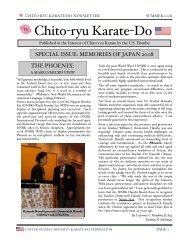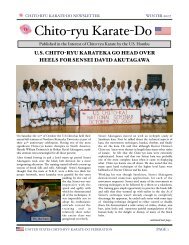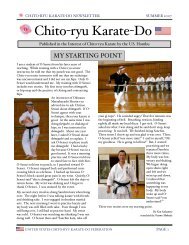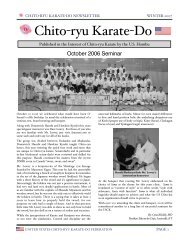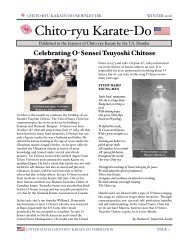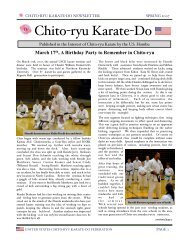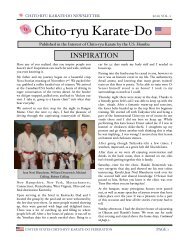2009 Volume 3 - United States Chito-ryu Karate Federation
2009 Volume 3 - United States Chito-ryu Karate Federation
2009 Volume 3 - United States Chito-ryu Karate Federation
Create successful ePaper yourself
Turn your PDF publications into a flip-book with our unique Google optimized e-Paper software.
CHITO-RYU KARATE-DO NEWSLETTER <strong>2009</strong> VOL. 3<br />
SHOCHUGEIKO <strong>2009</strong> PART 1<br />
The <strong>2009</strong> Shochugeiko held at Big Bone State Park was<br />
nothing short of amazing. Held on July 11, we were<br />
transported to the time when most martial arts were<br />
practiced outside and not confined within four walls.<br />
Training outside provided not only a different terrain but<br />
the ability to move around without having to worry about<br />
running into others. It also made me realize why you<br />
should always bring an old gi or come prepared for grass<br />
stains.<br />
Dometrich Hanshi and the author<br />
The day began with a short opening ceremony and an<br />
introduction of instructors and senior ranking belts.<br />
Once those were rattled off, Hanshi opened the seminar<br />
with remarks about what we were doing and why we were<br />
all gathered in the park for Shochugeiko.<br />
As the morning sessions began, we focused on basics and<br />
kata, with all belts practicing together as one. At times,<br />
senior students would demonstrate a technique and<br />
explain the movements to the class. The emphasis was on<br />
attention to details and thus each movement and each<br />
part of each movement must be correct. We<br />
concentrated on the placement and direction of each foot<br />
and the angle and motion of each strike or block. As each<br />
of the karate-ka went through the drills Black Belts<br />
walked the ranks, coaching individually. This personal<br />
attention encouraged us to get through the drills and<br />
focus on our individual skills and goals.<br />
As the morning continued, training focused on finding a<br />
deeper understanding of kata, beyond just remembering<br />
the techniques. By practicing traditional Taikyoku kata<br />
emphasis was placed on the idea that each movement<br />
builds upon the ones that came before it and is a strong<br />
foundation for the movements that will come after it.<br />
With guidance and motivation from black belts and<br />
senior students we sought to understand the importance<br />
of seisan and shiko-dachi stances.<br />
Hanshi brought us back together for remarks and after<br />
the dismissal of the younger participants, the afternoon<br />
sessions found us divided into ranking groups. While the<br />
senior belts worked on advanced kata, the afternoon<br />
sessions were primarily devoted to bo training and self<br />
defense.<br />
Practice started with a discussion of why we practice<br />
techniques with a bo staff, specifically discussing that a bo<br />
staff represents a possible weapon you may have available<br />
in a real-life situation, such as a broomstick or handle.<br />
Emphasis was placed on learning the fundamental<br />
concepts, holds and movements of the bo. I was<br />
fortunate to come from a dojo where bo kata is practiced,<br />
however the bo staff is not something that all students<br />
were familiar with. By breaking down the motions of<br />
Sakugawa no kon sho, all students were able to<br />
experiment with this new kata.<br />
The final session of the seminar started with the<br />
understanding that self defense begins with awareness,<br />
and that prevention is better than any fighting<br />
techniques. During this session techniques from<br />
different kata were utilized to represent the many<br />
applications of a single movement. Following the<br />
sessions all students were invited to stay for food and<br />
friendship.<br />
Matthew Scott and John Wellbrock<br />
My fellow karate-ka have shared great stories of training<br />
and seminars and initially I was intimidated by the<br />
majority of participants who were there. Having come<br />
alone from my dojo in Charlottesville, Virginia I was<br />
surrounded by a large number of black belts and I wasn’t<br />
sure if I could measure up. I soon forgot about my<br />
insecurities as I was welcomed into first the honbu dojo<br />
and later the park. <strong>Chito</strong>-<strong>ryu</strong> is a family, a group of<br />
people bringing an energy and passion to the art. At<br />
UNITED STATES CHITO-RYU KARATE-DO FEDERATION PAGE 3



